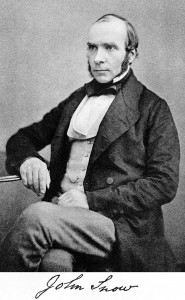Water-borne Diseases and Sanitation
London, England
 Understanding how diseases spread is key to their control. In 1854, John Snow, a leading Victorian physician, discovers that cholera is transmitted through contaminated water. He made this discovery by mapping a cluster of cholera cases in an area of London all using the same water pump. Researchers later discovered that the pump had been dug only a few feet from an old cesspit that was leaking fecal bacteria. Snow’s findings inspired fundamental changes in the water and waste systems of London, as well as other cities around the world. Then in 1902, American epidemiologist William Thompson Sedgwich published The Principles of Sanitary Science and Public Health, connecting rising pollution levels in the Merrimac river to the Lowell typhoid epidemic in 1890 and raising awareness on the importance of sanitation in U.S. urban areas. Jersey City becomes the first population center to chlorinate the water supply in 1908, drastically reducing typhoid rates.
Understanding how diseases spread is key to their control. In 1854, John Snow, a leading Victorian physician, discovers that cholera is transmitted through contaminated water. He made this discovery by mapping a cluster of cholera cases in an area of London all using the same water pump. Researchers later discovered that the pump had been dug only a few feet from an old cesspit that was leaking fecal bacteria. Snow’s findings inspired fundamental changes in the water and waste systems of London, as well as other cities around the world. Then in 1902, American epidemiologist William Thompson Sedgwich published The Principles of Sanitary Science and Public Health, connecting rising pollution levels in the Merrimac river to the Lowell typhoid epidemic in 1890 and raising awareness on the importance of sanitation in U.S. urban areas. Jersey City becomes the first population center to chlorinate the water supply in 1908, drastically reducing typhoid rates.
World Population : 170,060,000
Please rotate your device to landscape mode.
